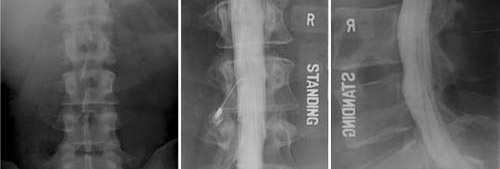Myelography (Mylogram)
Neck or back myelography is a diagnostic test that produces an image to help your doctor determine if anything is compressing nerves. Nerve compression may be caused by bone, disc, scar tissue, tumor, infection, cysts, or other structures.
The spinal nerves are enclosed in a thin covering, or sac called the dura. During a myelogram, a doctor injects a dye inside the dura. The dye is a material that can be seen on x-rays.
If there is tissue altering the flow of the dye into the regions where it normally spreads, this may indicate that nerve tissue is compressed. Myelography is used to evaluate several types of spinal conditions including stenosis or other conditions where nerve root compression is suspected.

- Do not eat any solid foods after midnight prior to your myelogram. You may have clear liquids the morning before your myelogram.
- Dress comfortably in a warm-up suit, sweats, or shorts – you will need to change into a gown.
- Let the nurse and doctor know if you are pregnant or may be pregnant, are diabetic, have a history of epilepsy or seizure, are allergic to any medication, or have had any reaction to x-ray dye or xylocaine.




- You will lie on your stomach and side.
- The skin in the area of the injection will be cleaned.
- A local anesthetic will be injected.
- A dye will be injected under the dura (sac containing the spinal cord).
- X-rays will be made.




- Often, a CT scan after the neck or back myelogram to get as much information as possible about the areas of nerve compression.
- You will be in a recovery room for 2 to 4 hours.
- You must have someone to take you home.
- Some patients will have a headache following a neck or back myelogram. If this occurs, the first treatment is to lie down and stay flat for several hours. Drinking fluids, particularly caffeinated beverages, may also help.
- If the headache does not resolve, contact your doctor’s office. They may recommend additional treatments.
- You will have a follow-up appointment with your doctor after the neck or back myelogram to discuss the findings.
- You may be told that the results of your myelogram will be sent to the doctor who ordered the test.
- This indicates that a report will be sent. If you are seeing a surgeon, they will need the actual images to give you the best information about your treatment options.
- You will need to obtain these from the imaging center (either on disc or on film) and be sure to bring them to your follow-up appointment.

